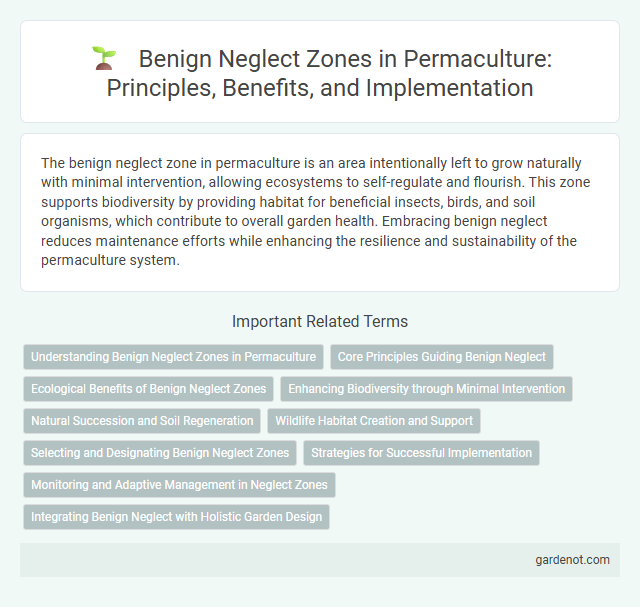The benign neglect zone in permaculture is an area intentionally left to grow naturally with minimal intervention, allowing ecosystems to self-regulate and flourish. This zone supports biodiversity by providing habitat for beneficial insects, birds, and soil organisms, which contribute to overall garden health. Embracing benign neglect reduces maintenance efforts while enhancing the resilience and sustainability of the permaculture system.
Understanding Benign Neglect Zones in Permaculture
Benign neglect zones in permaculture are deliberately low-maintenance areas designed to support natural ecosystems and encourage biodiversity. These zones allow plants and wildlife to thrive with minimal human intervention, promoting soil health and resilience. Understanding and implementing benign neglect zones helps create balanced, sustainable landscapes by integrating wild and cultivated spaces.
Core Principles Guiding Benign Neglect
Benign neglect in permaculture emphasizes minimal intervention to allow natural processes to restore ecosystem balance, fostering soil fertility and biodiversity organically. Core principles guiding benign neglect include observing natural succession patterns, respecting native species' roles, and prioritizing ecosystem resilience over immediate human control. This approach cultivates sustainable growth by enhancing self-regulation within garden zones, reducing labor while supporting long-term ecological health.
Ecological Benefits of Benign Neglect Zones
Benign neglect zones in permaculture promote natural regeneration by allowing ecosystems to self-organize, increasing biodiversity and soil fertility through minimal human intervention. These areas support native flora and fauna, enhancing habitat connectivity and resilience against environmental stressors. The ecological benefits include improved nutrient cycling, reduced erosion, and a balanced microclimate that sustains long-term ecosystem health.
Enhancing Biodiversity through Minimal Intervention
The Benign Neglect Zone in permaculture refers to an area where minimal human intervention allows natural processes to thrive, significantly enhancing biodiversity. This zone supports a diverse range of native plants, insects, and wildlife by preserving natural habitats and encouraging ecological balance. Maintaining this hands-off approach promotes soil health, natural pest control, and ecosystem resilience, crucial for sustainable permaculture design.
Natural Succession and Soil Regeneration
The benign neglect zone in permaculture harnesses natural succession to restore ecosystem balance by allowing native plants to thrive and outcompete weeds without human interference. This process accelerates soil regeneration through organic matter accumulation and microbial activity, enhancing fertility and structure over time. Emphasizing this zone reduces maintenance needs while fostering biodiversity and long-term landscape resilience.
Wildlife Habitat Creation and Support
The Benign Neglect zone in permaculture encourages natural succession by minimizing human interference, allowing native flora and fauna to thrive and establish diverse wildlife habitats. This zone supports ecological balance by providing shelter, food sources, and breeding grounds for local wildlife, enhancing biodiversity. Implementing Benign Neglect promotes sustainable ecosystems that sustain pollinators, predators, and other beneficial species crucial for garden health.
Selecting and Designating Benign Neglect Zones
Selecting and designating benign neglect zones in permaculture involves identifying areas that require minimal maintenance to foster natural ecological processes and biodiversity. These zones often include native vegetation patches, wildflower meadows, or buffer strips that support wildlife habitats and nutrient cycling. Strategic placement of benign neglect zones enhances landscape resilience, reduces labor input, and promotes sustainable ecosystem functions.
Strategies for Successful Implementation
Designing the benign neglect zone in permaculture involves selecting low-maintenance plants that thrive with minimal intervention, such as native grasses and hardy perennials. Incorporating natural mulching techniques and efficient water catchment systems reduces the need for frequent watering and soil disturbance. Establishing this zone near key resources ensures easy access while promoting biodiversity and ecological balance through less intensive care.
Monitoring and Adaptive Management in Neglect Zones
Monitoring and adaptive management in benign neglect zones are essential for understanding natural succession processes and biodiversity dynamics within permaculture systems. Regular observation allows practitioners to detect early signs of stress or invasive species, enabling targeted interventions that support ecosystem resilience. Adaptive management strategies in these zones promote long-term soil health, habitat complexity, and productivity by balancing minimal human interference with strategic care.
Integrating Benign Neglect with Holistic Garden Design
Integrating Benign Neglect with holistic garden design enhances permaculture efficiency by allowing natural processes to stabilize, promoting biodiversity and soil health without intensive intervention. This zone intentionally minimizes human interference, enabling plants and wildlife to self-regulate while supporting surrounding cultivated areas. Emphasizing observational gardening in the Benign Neglect zone leads to resilient ecosystems and sustainable productivity within permaculture landscapes.
Benign neglect zone Infographic

 gardenot.com
gardenot.com